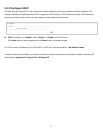
91
performance the ACK Timeout could be made longer to accommodate.
RTS/CTS
Adjustment of RTS Threshold can be done to turn on RTS. CTS Timeout will take effect only when RTS is turned on.
Unlike wired Ethernet, radio transmission may begin with a RTS (Request to Send) frame, and receiver responds with a CTS
(Clear to Send) frame. The RTS/CTS mechanism is called Channel Cleaning, all stations that received CTS will back off for
certain period of time, multiple of the slot time.
Each CTS packet has a NAV (Network Allocation Vector) number n, the channel is reserved for sender and receiver for
additional n-millisecond. The NAV guarantees the channel is free of interference in next n-millisecond. The last packet of ACK
will set NAV to zero, indicated that connection is done and free the channel to others.
CTS Timeout : CTS Timeout is in the range of 1~744 and set in unit of microsecond. The default value is 48
microsecond.
CTS Timeout will take effect only when RTS is turned on. Adjustment of RTS Threshold can be done to turn on RTS.
When hidden wireless stations are present in the wireless network RTS can be considered to turn on to minimize
collisions and increase performance. Ensure CTS timeout is long enough to avoid frequent re-transmission of RTS.
Slot Time and ACK/CTS Timeout settings for long distance links. It is important to tweak settings to achieve the
optimal result based on requirement.
Fragment Threshold : The Fragment Threshold is in the range of 256~2346 byte. The default is 2346 byte.
Each Wi-Fi packet can be divided into smaller packets, marked with a sequential fragment number and re-assemble in
the receiving ends. The purpose is to make a short frame, instead of long frame, transmitting by radio in a heavy noisy
environment. Because of sending smaller frames, corruptions are much less likely to occur. The pros is obvious, the cons
is the overhead for transmission. So, in a clean environment, higher fragment threshold can be an option to increase
throughput.
Fragmentation will be triggered by setting the Fragment Threshold, usually in Byte-length. Only when the frame size is
over the Threshold, fragmentation will take place automatically.
RTS Threshold : RTS Threshold is in the range of 1~2346 byte. The default is 2346 byte.
The main purpose of enabling RTS by changing RTS threshold is to reduce possible collisions due to hidden wireless
clients. RTS in AP will be enabled automatically if the packet size is larger than the Threshold value. By default, RTS is
disabled in a normal environment supports non-jumbo frames.
Short Preamble : By default, it’s “Enable”. To Disable is to use Long 128-bit Preamble Synchronization field.
The preamble is used to signal "here is a train of data coming" to the receiver. The short preamble provides 72-bit
Synchronization field to improve WLAN transmission efficiency with less overhead.
Tx Burst : By default, it’s “Enable”. To Disable is to deactivate Tx Burst.
With TX burst enabled, AP will send many packets in a burst, without collision detection and RTS/CTS for each packet.
TX Burst have better throughput but cause interference with other APs in channel.
WMM : By default, it’s “Disable”.


















